#roman religion
Text

The Parca and the Angel of Death by Gustave Moreau
#gustave moreau#art#symbolism#symbolist#angel#sword#halo#wings#parcae#parca#apocalypse#apocalyptic#pagan#christian#horseman#death#angel of death#four horsemen of the apocalypse#mythology#destiny#the fates#roman religion#roman mythology#christianity#religion#religious#red moon#moon#sun#horse
225 notes
·
View notes
Text
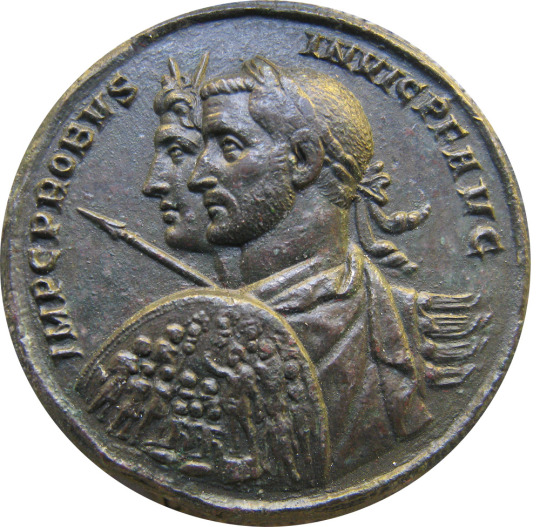
Coin minted ca. 280 CE by the Roman emperor Marcus Aurelius Probus (r. 276-282). Probus is shown in the company of Sol Invictus ("Unconquered Sun"), a late form of the solar deity whose worship had been promoted by Probus' predecessor Aurelian. The birthday of Sol Invictus (Dies Natalis Solis Invicti) was traditionally celebrated on Dec. 25. On this coin, Probus, who was constantly on campaign during his brief reign, is shown prepared for battle with shield and spear, alongside Sol Invictus, who wears his characteristic radiant crown. Now in the National Museum of Denmark, Copenhagen. Photo credit: ChrisO/Wikimedia Commons.
#classics#tagamemnon#Ancient Rome#Roman Empire#ancient history#Roman history#Probus#M. Aurelius Probus#Roman religion#Ancient Roman religion#religio Romana#Sol Invictus#art#art history#ancient art#Roman art#Ancient Roman art#Roman Imperial art#coins#ancient coins#Roman coins#Ancient Roman coins#numismatics#ancient numismatics#Roman numismatics#National Museum of Denmark
307 notes
·
View notes
Text
While checking around for my “Roman gods are not Greek gods” posts, I found back this tripartition of mythology, which is actually a fact that everybody should kno about if they want to dabble in Greco-Roman myths (especially Greek myths).
We know that, during Antiquity, the Romans and the Greeks thought that there wasn’t just one, but three different types of “theology” - three different views, perceptions and reception of the gods.
The first theology was the theology of the priests and of the state - aka, religion. The Greek gods as perceived and described by religion, as honored through rituals and festivals.
The second theology is the “mythic theology” - what we call “mythology today”. It is a set of legends, folktales and stories that are not part of religion, but rather used and carried by art - it is the gods are seen, perceived and described by the poets, by the epics, by the theater plays.
The third theology is the theology of the philosophers - who used the gods and their tales as images and allegories for various abstract or concrete topics. It is the gods as depictions and description of natural phenomenon, or the myths as a way to actualy exemplify a social fact or explain psychological workings.
For the classic Greeks and Romans, there was a clear divide between those three very different point of view of the gods. It was basically three different versions of the pantheon. This is notably why you will find texts noting that priests disliked and condemned the poets’ mythological works, due to them being blasphemous and making the gods too human when religion described them as perfect ; and it is also why the philosophers of old dissed on and rejected the literary works of mythology as nonsense only good to feed superstitions, because for them the gods weren’t characters or realities, but rather abstract concepts and rhetorical allegories.
This is something I feel needs to be reminded, because today these three different theologies have been mixed up into one big mess - as literary myths are placed one the same level as philosophical “myths” (actually texts taking the shape of myths), and both considered of outmost religious importance. When in fact, things were quite different...
EDIT: I was asked if there was a myth that could illustrate the three different theologies, and on the spot I would say “the affair between Aphrodite and Ares”.
This story originates from the “mythological theology”. It is primarily a story, and a good one. It is the story of a husband who discovers his wife is unfaithful and tries to get revenge, it is the story of an extra-marital affair gone wrong, it is typical set of divine shenanigans ending on a grotesque display of divine humiliation - it is an excellent narrative material for plays and poems (and the legend does originates from poems).
The story was also dearly beloved and reused by the “philosophical theology”, because the philosophers adored the idea of the love between Ares and Aphrodite - for them it was the perfect depiction of how the concepts of “love” and “war” , despite being seemingly opposite, attracted each other and were closely tied. For them, this story isn’t to be taken literaly as “a god cheated on another god”, but rather as “this is an allegory showing that love and war are two sides of the same coin, which is why Aphrodite falls for Ares despite being married to Hephaistos”. But for them the whole net part is just poetic nonsense invented to make people laugh ; or maybe they will reinvent them as a moral, cautionary tale that should be used to warn people of the dangers of unfaithfulness.
And then there’s the “religious theology”, the point of view of the priests - for whom such a story is mockery and sacrilege. You can imagine them saying: “You are making the gods look like fools! Gods don’t cheat on each other, gods don’t get captured in nets while butt-naked, gods don’t even sleep on beds - GODS DO NOT EVEN HAVE HUMAN FORMS IN THEIR NATURAL STATE - what the heck is this bullshit you’re saying, you’re just insulting the gods by turning them into lecherous humans and grotesque clowns for your vulgar story!” (This is a reconstitution and not the actual words of an Ancient Greek priest)
#greek gods#roman gods#greek mythology#greek religion#roman mythology#roman religion#ancient theology
611 notes
·
View notes
Text



Roman Water Shrine (Nymphaeum) at Chedworth Roman Villa, Gloucestershire
#roman#roman belief#roman living#roman religion#roman society#roman villa#Chedworth Roman Villa#Gloucestershire#roman empire#roman design#archaeology#relic#beliefs#outdoors#nature#natural spring#spring water#landscape
444 notes
·
View notes
Text
Roman & Hellenic Polytheism - they are Not the Same Thing
Listen you guys. This is something I see everywhere and it bothers the heck out of me.
It is so very important to remember that Roman polytheism, while it came to borrow stories from Hellenic polytheism, was a *completely different religion* with roots primarily in the Etruscan, not Hellenic, tradition.
Straight out the gate, Roman polytheism has a multitude of different gods without a so-called ‘Hellenic equivalent’. I can list at least ten off the top of my head and there were many, many more than that.
In instances where the Romans equated their gods with the Hellenic, there was already a long tradition of that god in their own country - they did not just take a Hellenic god and superimpose it onto their own similar deity - quite the contrary. They thought the Hellenic god was a form of *their* deity.
Only in cases where they shared a god, honouring them under the same name as their native country - for example Apollo, Isis, Mithras or Magna Mater - might we suppose there was a wholesale acceptance of that god as they were perceived in their country of origin - and even then, I strongly suspect it would’ve quickly taken on a distinctly Roman form.
The way in which these two religions, the Hellenic & Roman, with their two pantheons of gods, are conflated and misrepresented is incredibly widespread and horrifyingly reductive.
The trouble is, many Hellenic gods cannot now be recovered in their true Hellenic form, but must be viewed through a Roman lens; and that Roman lens, it should surprise no one to hear, saw Roman gods in their Roman form, even when couched in pseudo-Hellenic terms.
Just because we can’t now unpick the one from the other doesn’t justify us assuming they’re the same. We have plenty of evidence that they weren’t.
It would be like taking Plutarch’s history writing about classical Sparta, composed ~500 years after the fact, and assuming he was 100% correct simply because that’s one of the only ancient sources we have on the subject. We know this can’t be so - yet where the mythos is concerned, we leave this basic understanding of the ‘trouble with ancient texts’ at the door, and assume it’s all one - that the Romans have just ‘taken over’ Hellenic polytheism and made it their own. It is *infinitely* more complicated than that.
I always recommend reading ‘Religions of Rome’ by Beard, North & Price on the subject; it’s very in-depth and does what can be done to gain a picture of Roman religion as it’s own entity. It also makes a clear point of just how much we don’t know about ancient religion more broadly - an acknowledgement that is missing in so much discourse that goes on here.
#roman polytheism#hellenic religion#hellenic polytheism#roman gods#greek gods#greek mythology#roman religion#roman mythology#Ancient Rome#Ancient Greece
311 notes
·
View notes
Text
The intersection of Roman law, pragmatism and religion never fails to amuse me. Has Jupiter claimed part of your farm with a lightning strike? Worry not, just put that god in a shoebox!

"Communicating with the Gods," Jörg Rüpke, in A Companion to the Roman Republic, ed. Nathan Rosenstein and Robert Morstein-Marx.
#brought to you by the same people that consulted sacred chickens before battle#communicating with the gods#jorg rupke#a companion to the roman republic#roman religion#jlrrt reads
34 notes
·
View notes
Text

"If you have ever come upon a grove that is thick with ancient trees rising far above the usual height and blocking the view of the sky with their cover of intertwining branches, the loftiness of the forest, the seclusion of the spot, and your wonder at the unbroken shade in the midst of open space will create in you the feeling of a divine presence".
-Seneca the Younger on the numina.
#Seneca the younger#seneca#Lucilius#numina#numen#spirits#roman religion#nature#europe#tradition#indo-europeans#etruscan#julius evola#mircea eliade#mythology#myth#mos maiorum#Rome#jupiter#juno#minerva#divine presence#God
69 notes
·
View notes
Text

"Sol Invictus is a pagan celebration Emperor Aurelian established in 272 CE after his troops were inspired by a divine power on the battlefield. He declared Dec. 25 as the birthdate of the “Invincible Sun” and made the day a feast-day.
Not too long after, the Church decided to declare this same date to be Jesus’ birthday and soon the day was completely Christianized. Many pagan traditions were swallowed up as well."
C.H. 2018, Source: https://psuvanguard.com/merry-sol-invictus/
#sol invictus#paganism#holiday#conifers#pagan#roman history#roman religion#history#christmas#greetings#celebration#spqr#ancient rome
36 notes
·
View notes
Text
a little summary for the non-Italian-speaking folks who'll run into this post:
a capitolium - a tripartite temple, that is - has been discovered in the city of Sarsina, province of Forlì-Cesena, Italy. it most likely dates back to the 1st century BCE. more studies will be done on the building, which will probably lead to a deeper understanding of ancient Roman religion.
#roman paganism#roman polytheism#roman pantheon#religio romana#cultus deorum#roman polytheist#ancient roman religion#paganism#roman religion#archeology
22 notes
·
View notes
Text

IF YOU ARE READING THIS, THAN YOU HAVE FOUND HER.
BEHOLD ABUNDANTIA,THE GOOD GODDESS. WEALTH, ABUNDANCE,BOUNTIFULNESS, RICHNESS, FORTUNE.

In Roman religion, Abundantia was the personification of prosperity and abundance. She was a beautiful goddess who was known for bringing grain and money in a cornucopia to the mortals as they slept. Let’s take a closer look at the goddess and the role she played in Roman mythology.
Abundantia’s parentage is unknown as there are hardly any records about the goddess. What is known is that she presided over the flow of money, valuables, fortune, prosperity and success. Her name was derived from the word ‘abundantis’ which means riches or plenty in Latin.
Abundantia was almost always depicted with a cornucopia over her shoulder. The cornucopia, also known as the ‘horn of plenty’, is a symbol closely associated with the goddess and signifies what she stands for: abundance and prosperity. Sometimes her cornucopia contains fruit but at other times it carries gold coins, which magically spill out of it.
Some sources say that Abundantia was a vision of exceptional beauty and purity. Just like she was beautiful on the outside, she was also beautiful on the inside. She was a lovely, patient and kind goddess who took pleasure in helping people and was very generous with her gifts.
In Greece, Abundantia was identified with Eirene, the goddess of wealth and prosperity. She was also often identified with the Gallic goddess of prosperity, known as Rosmerta. The goddess was also popular among gamblers who called her ‘Lady Fortune’ or ‘Lady Luck’.
The Romans believed that their deities took control of everything that went on in their lives and, just like in Greek mythology, every task and occupation had a Roman god or goddess presiding over it.
Abundantia’s role was to help mortals with everything related to money and financial success. She would help people to make major purchases, influencing and guiding them to protect their investments and savings and to wisely handle their finances.
The goddess also had the power to remove all the concerns and worries that people had about money. This was useful since she helped eliminate negativity in their lives due to financial worries. In this way, she not only brought them wealth and prosperity, but she also brought them success and good fortune. Her cornucopia was said to be filled with coins and grain which she would occasionally leave at people’s doorsteps as a little gift.
According to Ovid, the Augustan poet, Abundantia featured in the myth of the river god Achelous. The legendary Greek hero, Heracles, had defeated Achelous by ripping off one of his horns. The Naiads, who were nymphs in Greek mythology, took the horn and turned it into a Cornucopia and gifted it to Abundantia to use. This is only one version of the Cornucopia’s origin but there are many other myths that provide various explanations.
In some accounts, the Cornucopia was said to be a horn of Amaltheia, the mystical she-goat which Jupiter, the god of the sky, broke off by accient. To comfort Amaltheia, Jupiter caused it to keep refilling itself with food and drink. Later, the horn went into the hands of Abundantia but how it happened isn’t exactly clear. Some say that Jupiter gifted it to her to use.

THE WORSHIP OF ABUNDANCE
As a minor goddess, there were very few temples that were specifically dedicated to Abundantia. The Romans worshipped her by making offerings and praying to her. Their offerings included milk, honey, fruit, flowers, grain and wine and they also sacrificed birds and animals in her name. In Roman religion, the gender of the sacrificed animal was supposed to correspond to the gender of the deity to whom the animal was being offered. Because of this, sacrifices that were made to Abundantia were a cow, heifer, female bird, sow or a white ewe.
Abundantia was a minor goddess in Roman mythology, but she was one of the most loved deities of the Roman pantheon. The Ancient Romans revered her because they believed she eased their worries and helped them in their times of financial difficulty.
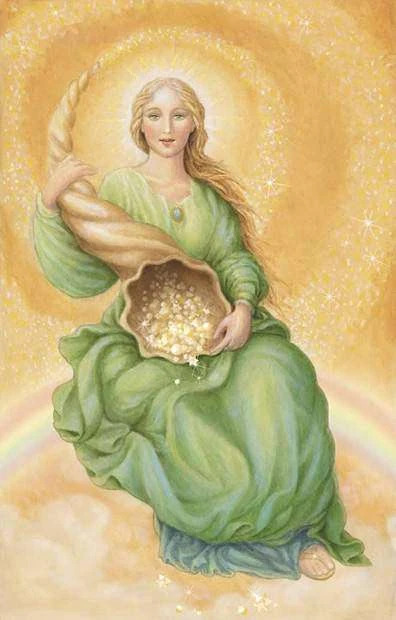
HER IMAGE
The goddess of abundance and prosperity was depicted on Roman coins that were issued in the 3rd century CE. On the coins, she’s portrayed seated on a chair with her famous symbols, the Cornucopia, which she holds or tips over slightly to make the riches pour out. She’s sometimes depicted on coins with ears of wheat and at other times, she stands on a ship’s prow, representing the Roman Empire’s overseas conquests.

IF YOU ARE A HEATHEN OR A HEDONIST OF A PURE HEART, OR CAN APPROACH THIS GODDESS WITH THE SAME LEVEL OF LOVE, RESPECT, AND COMPASSION AS YOU WOULD A LOVING CARING MOTHER, YOU CAN DEFINITELY COUNT ON HER TO LEAN ON FOR SUPPORT. YOU YOU ARE SEEKING GREATER WEALTH OR ARE INVOLVED IN FEEDERISM AND SEEKING TO BETTER PROVIDE AND STOCK UO ON FOOD, SHES YOUR GODDESS, SO LONG AS YOUR A GOOD PERSON AT HEART THAT IS.
#hedonism#abundantia#roman goddess#roman religion#paganism#prayforturkey#cornucopia#bountiful#fruitful#mother goddess#luxury#minor gods#gay feederism#plentiful#prosperity#wealth#hellenic pagan#gluttnous#royalty
35 notes
·
View notes
Text
5 notes
·
View notes
Text

The Triumph of Neptune and Amphitrite by Frans Francken the Younger
#frans francken the younger#art#neptune#amphitrite#roman mythology#greek mythology#roman religion#mythology#religion#mythological#roman#ancient rome#antiquity#ancient greece#ancient greek#europe#european#classical#gods#goddess#mythical creatures#triton#merman#mermaid#nereids#mermaids#trident#chariot
29 notes
·
View notes
Text

The god Hesperus sits on a throne and holds a tall torch. Around him are Apollo-Helios (identifiable by his halo), Aphrodite (crowned), and other deities. Wall painting in the Fourth Style from the exedra of the House of M. Gavius Rufus (VII.2.16) at Pompeii; now in the National Archaeological Museum, Naples. Photo credit: ArchaiOptix/Wikimedia Commons.
#classics#tagamemnon#Ancient Rome#Roman Empire#Pompeii#Greek religion#Ancient Greek religion#Hellenic polytheism#Roman religion#Ancient Roman religion#religio Romana#Dionysus#Dionysos#Helios#Aphrodite#art#art history#ancient art#Roman art#Ancient Roman art#Roman Imperial art#wall painting#fresco#Fourth Style#NAM Naples
522 notes
·
View notes
Text
The myth of Dionysos (3)
For the previous posts, see here and here.

V) The cult of Dionysos : Outside the city, inside the city
Such a god apparently does not have his place in the Ancient Greek city. Séchan-Lévêque reminds us that his religion, at the same time joyful and wild, is centered around the “thiasus”, that is to say a gathering of male and female beings joining outside of any civic or familial setting. According to Euripides’ description and to the various visual depictions of Ancient Greece, all the cultural elements surrounding Dionysos are the very opposite of the rational organization of a State. His cult takes place on the countryside, in woods and mountains. It takes place at night. The participants wear an animal skins over their clothes (or replacing their chiton), their hair is wild or crowned by ivy or laurel, their belt is made of a snake or a baby leopard hangs from it ; in one hand they hold the thyrsus and in the other a small animal (hare or young fawn). The music played for Dionysos is strange: flutes, tympanum and castanets. His ceremonies are chaotic: wild dances, convulsions, exhausting races. His sacrifice is performed by ripping apart animals before eating their raw flesh. The thiasus could be made of men, but the most famous of all the thiasus is the female one, and its members are called the Menads, the Bacchants, the Thyads, the Bassarides… Ordinarily, women of Ancient Greece were locked up inside the gynaeceum, so to have them becoming wild and savage makes the cult of Dionysos a unique one, set apart by the official religious events of the city, since he breaks all urban religious rules. Similarly, the mysteries of Dionysos unite together men and women, citizens and slaves, which meant breaking apart the Ancient Greek social hierarchy.
And yet, this Dionysos that destroys the order of the city is greatly honored at Delphi, the domain of the Greekest of all gods, Apollo. The Pythia reminds the audience, in Aeschylus’ Eumenids, that she honors the nymphs over which rules Bromios and his Bacchants, with explicit references to the story of Pentheus. Every year, during the three months of winter, while Apollo leaves for Hyperborea, Dionysos replaces him. And every two years, the Thyads of Delphi and the Bacchants of Athens, holding torches, celebrate on mount Parnassus the son of Semele. In the adyton of Apollo’s temple, legends claimed Dionysos’ tomb could be found. The poets frequently exchanged the names and nicknames of the two deities: Aeschylus wrote in Bassarids of “Apollo with ivy, a bacchant and a seer”, while Euripides in Likymnion wrote of “Lord Bakchos, friend of the laurel, Pean-Apollon with the beautiful lyre”. As such, despite Nietzsche’s strict opposition between the god of harmonious restraint and the deity of savage drunkenness, the two gods are actually far from being polar opposites.
Dionysos also finds a home at Athens. We already saw several of the festivals in his honor there: Apaturia, Anthesteria, Oschophoria… But to those can be added the agrarian Dionysia, the the Lenaia, and especially the great Dionysia: during those, contests of dithyrambic, of tragedies and of comedies were held, gathering an audience coming from all four corners of Greece. Traditionally, the tragedy, the “tragodia”, is read as meaning “the song of the goat”, tragou-ôdè, since the goat was the animal traditionally sacrificed to the god. During the first day of the Great Dionysia, the statue of Dionysos was carried inside the “orchestra”, at the very heart of the city. And during the contests, a place of honor was kept for the priest of Dionysos. The marginal god clearly earned his place among men and Olympians.
Because, according to the Bacchants, inside the Dionysian chaos, there si a superior order, an “eukosmia” that unfortunately Pentheus fails to see, since he is a young tyrant filled with hubris. However the wise rulers of Athens did perceive and honor this superior order – unlike the Roman Senators that, in 186 BCE, harshly repressed any participations to the Bacchanals.
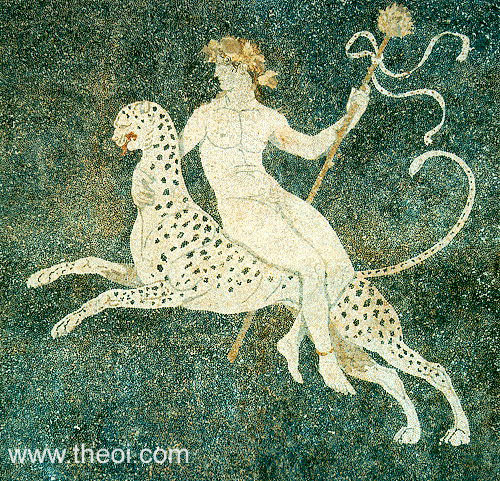
VI) Dionysos in service of political and religious doctrines: various uses
Multiple, complex, contradictory and shapeshifting: the god offered to the political and religious domains a very malleable material. For example, there are obvious links and mutual influences between the eastward journey of Dionysos and the eastward journey of Alexander. Alexander, just like his soldiers, and just like his historians, know of the story of the god’s travel to the East – the Dionysos of Euripides, in the Bacchants, said himself: “I left Lydia with his gold-fertile fields, I left the plains of Phrygia for the sun-burned plateaus of Persia, the walled cities of Bactrian, and the land of the Medes, frozen by winter ; and happy Arabia ; and finally all of Asia, laying by the salted waters…” Alexander took his army on the very steps of Dionysos. Of course, the Great was going to make the god the patron of his expedition, and as such Alexander was celebrated as the “new Dionysos” (a title that future rulers of Alexandria will also bear). The parallel grows stronger with the encounter by Alexander’s army of a town named Nysa, located near the mount Meros (a word that sounds similar to the Greek word for “thigh”) – the prince claimed the people of Nysa were descendants of the Greek people that Dionysos took with his on his own journey. However, in a complete circle, the adventure of Alexander the Great influenced greatly Dionysos’ own travels. India, for example, was never named in the tale of the Bacchants. But after the exploits of Alexander, Dionysos became the conqueror of India. Poets, painters and sculptors all depicted him taking part in this “war of India” that Euripides had never heard about. In the 5th century CE, this tale grew to enormous proportions thanks to Nonnus’ Dionysiaca, an epic in 48 chants, and where the Indian travel is described from chant 13 to 40.
Despite the recent doubts of some scholars, there is a possibility that Cesar and Augustus used for their political agenda the glory of this god celebrated everywhere in the oriental part of the Roman empire, and even in Rome itself – by both the Greco-Oriental population and the administrative elite of the Hellenism. Indeed, the assimilation between Dionysos and the Latium god Liber Pater had been done for a long time by now, and that despite some strong oppositions (such as the stern repression of the cult of Dionysos in 186). And the success of this religion was noticed by the political authorities. Servius commented what Virgil wrote in his Bucolics, about how Daphnis, on a “chariot pulled by Armenian tigers”, was the first to introduce the “thiasos of Bacchus”. Servius reminds his reader that in truth, it was Cesar that first brought the “mysteries of Liber Pater” to Rome – and as such behind the triumph of Daphnis, one reads as much the travels of Alexander as the exploits of Cesar… Two men that Augustus claims to be the heir of.
This “politic of Dionysos” knew its climax between the second and third century CE, through Hadrian the philhellenic, who demanded to be called the “new Dionysos”. In the same tradition as Alexander the Great, and as the many Hellenistic rulers, from Gallian (who, while leading a double fight against the Barbarians and the Christians, wanted to return to the Greek tradition) to Elagabalus (who had the habit of driving a chariot pulled by lions and tigers).
Dionysos was also used for philosophical and religious agendas. As such, the Orphics, reused in their beliefs the myth of the god’s murder by the Titans. Marcel Detienne wrote about how the myth of Dionysos was the perfect illustration for the main teaching of Orpheus: refrain from murder. In its double sense of 1) do not kill your fellow human being ; but also as 2) do not eat meat. On top of that, Dionysos’ resurrection echoed the belief in palingenesis of the disciples of Orpheus.
With this context, it makes sense that Christian writers, such as Clement of Alexandria or Firmicus Maternus, focused their attacks onto a myth that, for them, was a caricature of their beliefs and a parody of the sacraments of their own religion. Passion and Resurrection (Gregory of Nazianzus even used three hundred verses of the Bacchants in his Christus Patiem), Eucharist, and even the concept of Original Sin – because Dion Chrysostom wrote that mankind was born from the ashes of the Titans mixed with the earth. As such, humanity was part at the same time of the crime of the Titans, and of the divinity of Dionysos (who had been eaten by the Titans). The Christian attacks were also very strong because Orphism, through this myth, had brought to the cult of Dionysos the theology that it lacked (since in the Mysteries of Dionysos, the ritual had a larger and stronger place than the theory).

VII) A diversity of interpretations
In front of such a complex and elusive personality, it is impossible to give just one interpretation of the character of Dionysos. From the third millennium BCE to the fall of the Roman Empire, the god constantly played a role – his figure was constantly shaped by societies, governments and people. As such, the interpretations offered by mythologists allow us to better understand Dionysos, but they will never be complete or exhaustive. As much, all they can do is bring to light some key elements of his being.
While the mythologists of the early 20th century were prone to excesses, the interpretations of names such as Frazer, Farnell or Miss Harrison are still very interesting. Dionysos is first and foremost a vegetation god, a fecundity god, a chthonian god. Many of his ceremonies are rituals celebrating renewal. He is a god of plants; his emblem if the thyrsus, a branch or a reed stalk crowned by leaves of ivy/vine, or by a pine cone. All these plants play a important role in both the rites and the myth of Dionysos, even though from the 7th century BCE onward he specializes himself as the god of the grapevine and of wine. Dionysos is the lord of the tree. As we saw before, he is related to the Oriental mother-goddesses and to the Aegean world. His wife is Ariadne – who might have been during the Classical era a human, but that was once an Aegean goddess of vegetation. Dionysos is the master of both animal and human fecundity – his favorite companions, the satyrs, the donkeys, the goats, the bulls, are all depicted with a very large phallus. He went down into the Underworld to bring back his mother Semele, and he presides over the Anthesteria, which was a celebration of the dead. Zagreus was believed to have for a mother Persephone, and for a father either Zeus or Hades – and in fact, Zagreus was sometimes identified as being an alternate identity of Hades. This chthonian side of Dionysos was developed in his mysteries: the initiation, the purifications, the teaches of sacred formulas have for a main purpose to allow the dead to escape all the dangers that threaten their travel to the afterlife ; and ultimately, to allow them to find happiness in the Hades.
The Bacchic drunkenness and the possessios/trances of the Menads have also brought forward numerous psychological, psychoanalytical and ethnological commentaries. The dances of the Bacchants were compared to those of the whirling dervishes, of the Jewish Hasidim, of the Siberian shamans and of the American Shakers. This phenomenon was proven to have been widespread throughout all of the Antique Mediterranean world – and to still be existing today in a part of Africa. Séchan-Lévêque noted that the “delirium of the Bacchants” was in many ways similar to neuropathic manifestations. Convulsive and spasmodic movements, the body bending backwards, the neck being thrown around… Both also involve a feeling of depersonalization, the feeling of the self being invaded by an outside persona or entity. Psychanalysts saw a parallel between the mechanisms of the Dionysian possession and various concepts of child-psychanalysis: they claimed that the ritual of the god had a therapeutic effect. The Dionysos-Hades becomes a Dionsyso-Asclepios.
Another theory that should not be ignored is the theory of the “pharmakos”, or the theory of the “scape-goat”, that was popularized by Frazer and then by René Girard in his interpretation of Euripides’ play. The tragedy of the Bacchants presents itself at first like a ritual bacchanal. All differences are erased: all take part in the celebration, be them old or young, male or female, citizens or slaves. But the party goes wrong, violence arrives. The difference becomes an inversion: women perform martial activities, men disguise themselves into women. Human and animal worlds are confused for one another: the Bacchants rip apart of a herd of cow they mistake for men, Pentheus ties up a bull he thought was Dionysos, Agave murders Pentheus while seeing before her a lion. Pentheus, in his transvestite outfit, is a Carnival prince, a temporary king – as Jeanne Roux notes, he is at the same time the scape-goat carrying with him all the soiling and vices of the past year, and the sacrificial victim to open a new and clean year. The symbolism becomes even more obvious due to the fact that Pentheus, in his female disguise, climbs on top of a pine and falls from it. A. G. Bather, in The Problem of the Bacchae (Journal of Hellenic Studies, 1894), noted that in Russia, during Pentecost Thursday, there was a very similar ritual. Villagers had to cut down a young pine-tree and disguise it as a woman before bringing “her” to the village in great joy. Three days later, on Trinity Sunday, the wooden figure was taken out of the village and thrown in a body of water. In Euripides’ play, at the end of the party, the pine-tree is ripped away, the king is killed and torn apart: Pentheus is inflicted a diasparagmos (a dismemberment) by the hands of his own mother and of his aunts. Which in turn will become new scapegoats, as they will be banished from the city afterwar. A new order will rule over Thebes: as René Girard notes in La Violence et le sacré (Violence and the sacred), Dionysos is the god “of the successful lynching”. However we saw previously that Pentheus is the double of Dionysos. Just like his adversary/reflection, the god, in the myth of the Titans, also suffers a diasparagmos. As such there is an identification between the pine-tree that is uprooted, and Dionysos Dendritès, god of the trees. While in Euripides’ play the god appears as the organizer and the force behind the scapegoat ceremony, it is possible that in ancient times he used to be the victim of said ceremony.
Finally, numerous analogies bring Dionysos close to the “kouroi”, the novices that undergo initiation-trials. Pausanias describes how Cadmos placed Semele and young Dionysos in a chest that was thrown in the water and ended in Brasiai/Prasiai (a port of Laconia). This type of trial was also known by other great heroes – Perseus, Moises, Romulus. Just like the initiated ones of the three first classes of Ancient India (the dvija), Dionysos is “twice-born”. Just like Achilles, Herakles and Jason, who were all raised by the horse-man Chiron, Dionysos knew animal-men during his childhood: the goat-men that were the satyrs and the silenes ; but also wolf-men, such as Lycurgus (whose name means “He who acts as a wolf, from lukos “wolf” and “ergon”, action), or Athamas (that Apollodorus compares to a wolf). Just like Achilles that was disguised as a girl, just like Theseus that was mocked for his dress and braided hair, just like Herakles that had put on a dress before queen Omphalus, Dionysos knew the experience of the feminine cross-dressing. Just like Achilles, Melicertes, Herakles, Pelops and Jason, there is the trial of the cauldron – killed, dismembered and boiled, he was resurrected. (Jeanmaire wrote that it is a legend with a strong initiation symbolism, and that seems to answer to very archaic practices explaining or interpreting the dangers that threaten children and teenagers). Just like in African initiation rituals, the rhombus played a key part in his death-resurrection. Just like Pelops, whose homosexual loves for Poseidon have analogies with the initiation of young Cretans, Dionysos, with the mysterious Prosumnos, acts as the hero of an initiation-adventure. Just like Odysseus, Herakles, Orpheus, Theseus, Aeneas or Jason (the latter only through symbolism), he went into the Underworld. Finally, just like Theseus and Gilgamesh, he plunged in the water (and even twice) to escape Lycurgus and to find his mother in the Hades. All those trials are so many shapes of initiation rituals, of obligatory rites of passages allowing the teenager to leave the world of childhood and to join the world of adults.
As such, despite all the critical efforts to understand Dionysos’ personality, to bring an exhaustive interpretation including both his complexity and diversity, the god keeps escaping our minds, breaking our settings, removing the chains with which we would try to bind him. All the way until the end, he will stay elusive. So let us remember how, in both the Homeric hymn to Dionysos, and the Bacchants, Dionysos is always presented as the “un-binder”, as the “Eleuthereus”, the “Luaios”, the “Lusios”, the one that detaches, that sets free ; the god on who all ropes and all binds fall to the ground, the god who can escape any net without effort, the entity that can never be trapped because all those that think they caught him are in fact not even touching him.
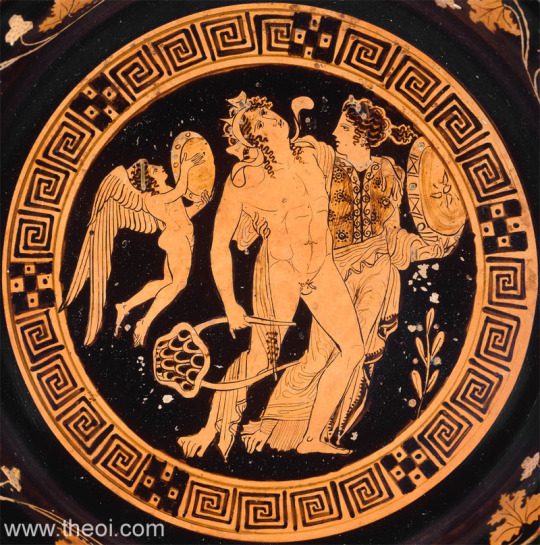
#dionysos#dionysus#greek god#greek gods#mythology#ancient greece#ancient rome#roman religion#greek religion#roman gods#roman mythology#alexander the great#bacchants#pentheus#orphic cult#orphic religion
46 notes
·
View notes
Text


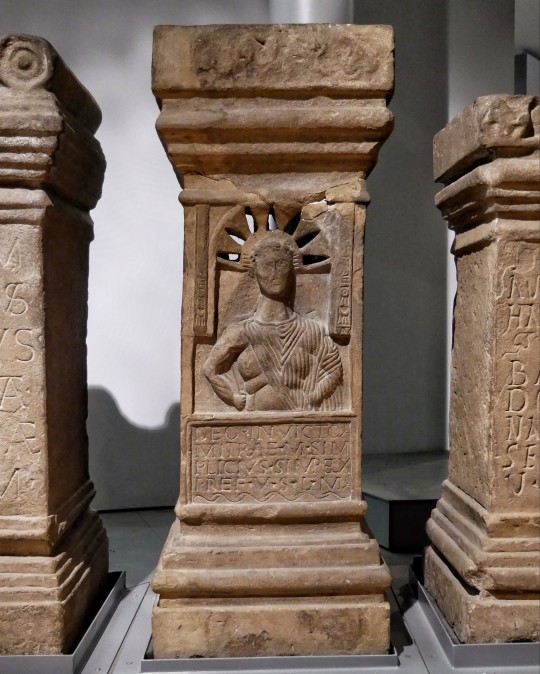
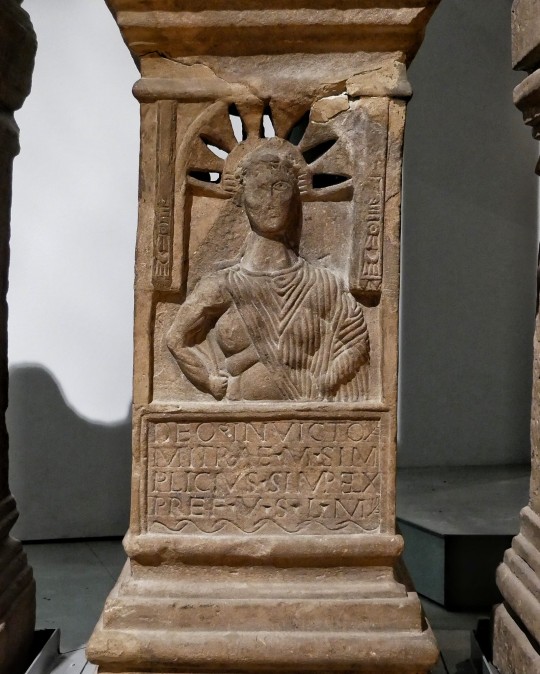
Roman Altar found in Carrawburgh Mithraeum, Hadrian's Wall, Great North Museum, Hancock, Newcastle upon Tyne
#roman#roman army#roman fort#roman altar#hadrian's wall#archaeology#roman relic#roman religion#romans#deity#mithras#mithraeum#ancient cultures#ancient living#Northumberland
191 notes
·
View notes
Text
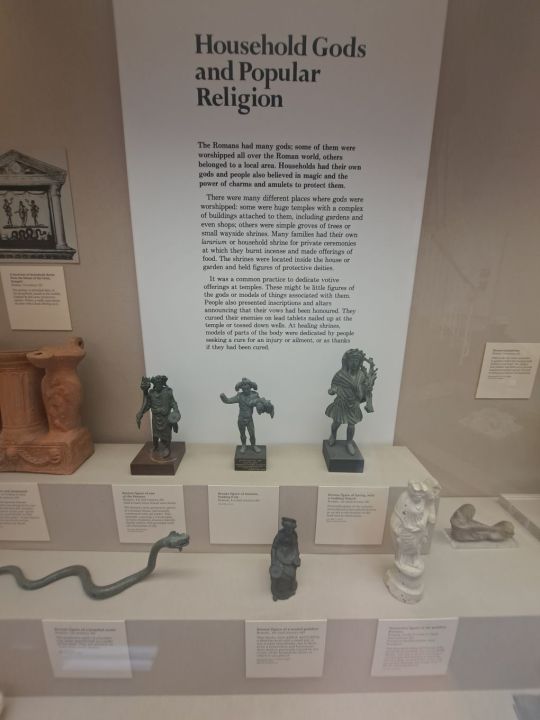

Roman Household gods
* 1st-3rd century CE
* British Museum
London, July 2022
68 notes
·
View notes